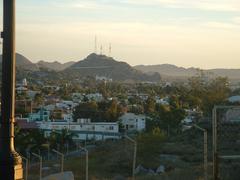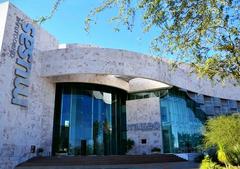
Visiting Cerro de la Campana: Hours, Tickets, and Tips
Date: 18/07/2024
Introduction
Nestled in the heart of Hermosillo, Sonora, Mexico, Cerro de la Campana, or ‘Hill of the Bell,’ stands as a testament to the rich historical and cultural heritage of the region. Recognized for its iconic bell-like shape, this landmark has played a pivotal role throughout various historical epochs, from its early use by indigenous groups like the Seri and Pima peoples to its strategic significance during the Spanish colonization and the Mexican Revolution. The hill’s name is derived from the unique bell-like sound produced when its rocks are struck, adding a layer of mystique to its already captivating allure. Over the centuries, Cerro de la Campana has evolved from a strategic lookout to a cultural and recreational hub, drawing visitors with its panoramic views, historical markers, and vibrant community events like the annual Fiestas del Pitic. As a major tourist attraction, it not only contributes to Hermosillo’s local economy but also serves as an ecological site teeming with native flora and fauna. This guide aims to provide a comprehensive overview of Cerro de la Campana, covering its history, visitor information, travel tips, and nearby attractions, ensuring that you have all the information needed for an unforgettable visit. For more details, you can visit the official tourism website of Hermosillo.
Table of Contents
- Introduction
- Early Inhabitants and Pre-Colonial Era
- Spanish Colonization and Naming
- 19th Century Developments
- 20th Century - Urbanization and Modernization
- Cultural Significance and Symbolism
- Preservation Efforts and Environmental Impact
- Visiting Hours and Tickets
- Travel Tips
- Nearby Attractions
- Accessibility
- FAQ
- Conclusion
- Call to Action
Early Inhabitants and Pre-Colonial Era
Cerro de la Campana has been a significant site for centuries, long before the arrival of Spanish colonizers. The region was originally inhabited by indigenous groups, including the Seri and Pima peoples, who utilized the hill for its strategic vantage point.
Spanish Colonization and Naming
The arrival of Spanish explorers in the 16th century marked a significant turning point. The hill was named ‘Cerro de la Campana’ due to its bell-like shape, and it was used as a lookout point by the Spanish colonizers.
19th Century Developments
In the 19th century, Hermosillo began to grow, and Cerro de la Campana played a crucial role. It became a popular spot offering panoramic views and was used for various civic and military purposes.
20th Century - Urbanization and Modernization
The 20th century brought significant changes. The hill became more accessible, and efforts were made to develop it as a tourist attraction. Roads and viewing platforms were constructed, transforming it into a popular destination.
Cultural Significance and Symbolism
The hill holds deep cultural significance and is a symbol of Hermosillo’s identity. It has been featured in local art, literature, and folklore, further cementing its place in the cultural fabric of Hermosillo.
Preservation Efforts and Environmental Impact
Recent years have seen a growing awareness of the need to preserve Cerro de la Campana. Environmental organizations and local authorities have collaborated on initiatives to promote conservation and responsible tourism practices.
Visiting Hours and Tickets
Cerro de la Campana is open to visitors daily from 8:00 AM to 8:00 PM. Admission is free, but donations for maintenance and conservation are appreciated. Special guided tours are available on weekends for a small fee.
Travel Tips
- Best Time to Visit: Early morning or late afternoon for the best views and cooler temperatures.
- What to Bring: Comfortable walking shoes, water, and a camera to capture the stunning views.
- Safety Tips: Stay on marked paths and be cautious of the terrain.
Nearby Attractions
- Plaza Zaragoza: A historic plaza located nearby, perfect for a leisurely stroll.
- Catedral de la Asunción: An architectural marvel located in downtown Hermosillo.
- Museo de Culturas Populares: Offers insights into the local culture and history.
Accessibility
While the hill is accessible by car, the summit requires a short hike. There are viewing platforms that are wheelchair accessible, making it possible for everyone to enjoy the views.
FAQ
Q: What are the visiting hours for Cerro de la Campana?
A: The hill is open daily from 8:00 AM to 8:00 PM.
Q: How much does it cost to visit Cerro de la Campana?
A: Admission is free, but donations are appreciated. Guided tours on weekends have a small fee.
Q: Are there any guided tours available?
A: Yes, special guided tours are available on weekends.
Conclusion
Cerro de la Campana’s history is a testament to its enduring importance as a natural and cultural landmark in Hermosillo. From its early use by indigenous peoples to its role in the city’s development and modernization, the hill has remained a central feature of the region’s landscape and identity. Today, it continues to attract visitors from around the world, offering a unique blend of natural beauty, historical significance, and cultural heritage. For more information on Cerro de la Campana, you can visit the official tourism website of Hermosillo.
Call to Action
For more updates on Hermosillo’s attractions, download the Audiala app, check out other related posts, and follow us on social media.
References
- Title: Official Tourism Website of Hermosillo, 2024, Hermosillo Government https://www.hermosillo.gob.mx/turismo


